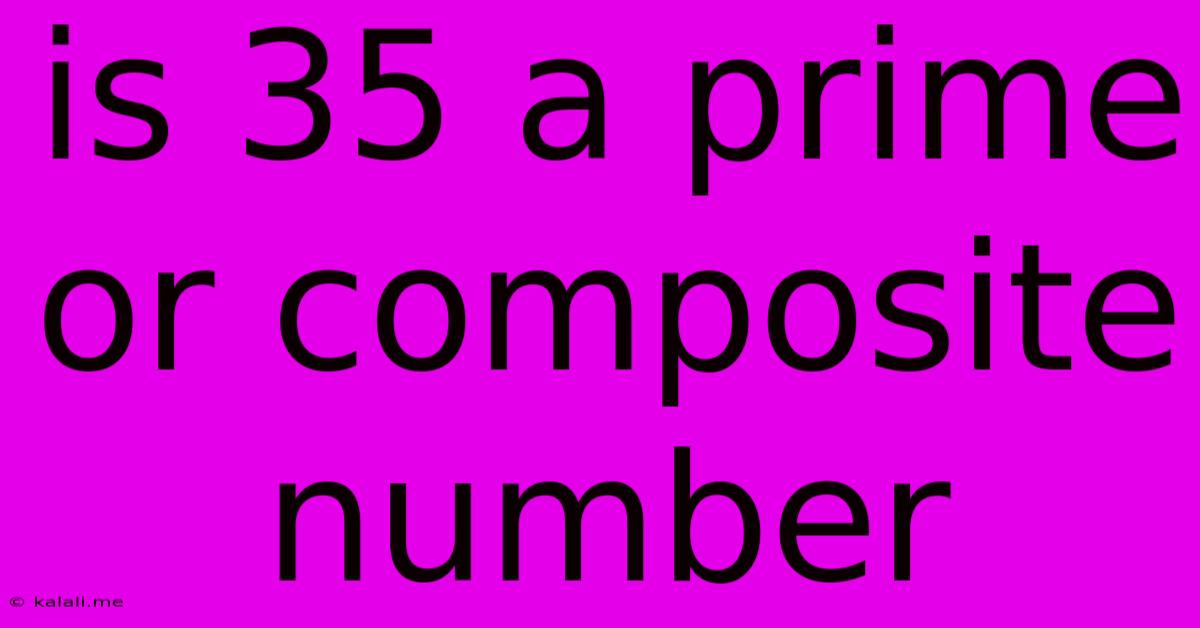Is 35 A Prime Or Composite Number
Kalali
May 09, 2025 · 2 min read

Table of Contents
Is 35 a Prime or Composite Number? A Simple Explanation
Is 35 a prime number or a composite number? This seemingly simple question delves into the fundamental concepts of number theory. Understanding the difference between prime and composite numbers is crucial for various mathematical applications. This article will clearly explain whether 35 is prime or composite and provide a solid foundation for understanding these number classifications. This will also cover how to identify prime and composite numbers, providing you with the tools to tackle similar questions independently.
What are Prime and Composite Numbers?
Before we determine the classification of 35, let's define our terms:
-
Prime numbers: A prime number is a natural number greater than 1 that has no positive divisors other than 1 and itself. In simpler terms, it's only divisible by 1 and itself. Examples include 2, 3, 5, 7, 11, and so on.
-
Composite numbers: A composite number is a positive integer that has at least one positive divisor other than 1 and itself. This means it can be factored into smaller whole numbers. Examples include 4 (2 x 2), 6 (2 x 3), 9 (3 x 3), and so on.
-
The Number 1: The number 1 is neither prime nor composite. It's a unique case in number theory.
Determining if 35 is Prime or Composite
To determine whether 35 is prime or composite, we need to check if it has any divisors other than 1 and itself. Let's examine its factors:
- 1 x 35 = 35
- 5 x 7 = 35
As you can see, 35 is divisible by 1, 5, 7, and 35. Since it has divisors other than 1 and itself (5 and 7), 35 is a composite number.
Identifying Prime and Composite Numbers: Useful Techniques
There are several techniques you can use to determine if a number is prime or composite:
-
Trial Division: This involves testing divisibility by each prime number up to the square root of the number in question. If no prime number divides the number evenly, it's prime. This method is efficient for smaller numbers but becomes less practical for larger ones.
-
Sieve of Eratosthenes: This is a more efficient algorithm for finding all prime numbers up to a specified integer. It works by iteratively marking the multiples of each prime number.
-
Factorization: Finding the factors of a number directly reveals whether it's composite. If you can find factors besides 1 and itself, it's composite.
Conclusion: 35 is Definitely Composite
In conclusion, 35 is not a prime number; it's a composite number because it has factors other than 1 and itself. Understanding the difference between prime and composite numbers is fundamental to various areas of mathematics, from cryptography to advanced number theory. By understanding these basic definitions and techniques, you can confidently identify the nature of any given integer.
Latest Posts
Latest Posts
-
What Is 30 As A Fraction
May 09, 2025
-
22 7 As A Mixed Number
May 09, 2025
-
How Many Cups Is 20 Fluid Ounces
May 09, 2025
-
What Is 6 Fl Oz In Cups
May 09, 2025
-
The Expected Outcome Of An Experiment Is Known As
May 09, 2025
Related Post
Thank you for visiting our website which covers about Is 35 A Prime Or Composite Number . We hope the information provided has been useful to you. Feel free to contact us if you have any questions or need further assistance. See you next time and don't miss to bookmark.